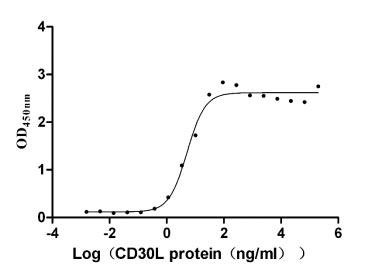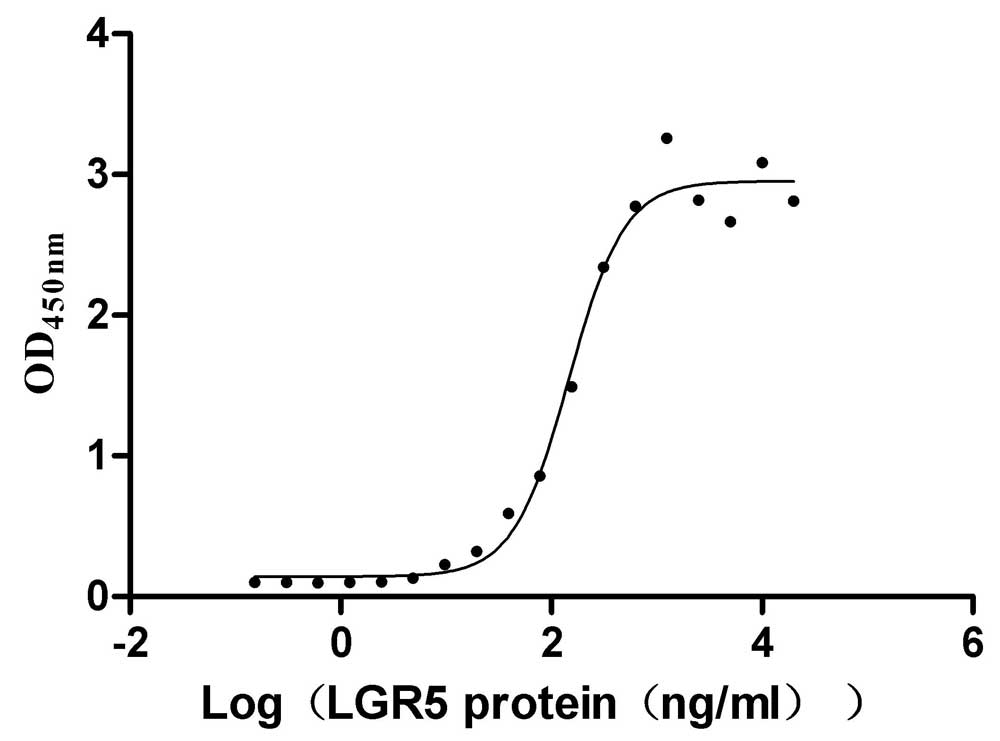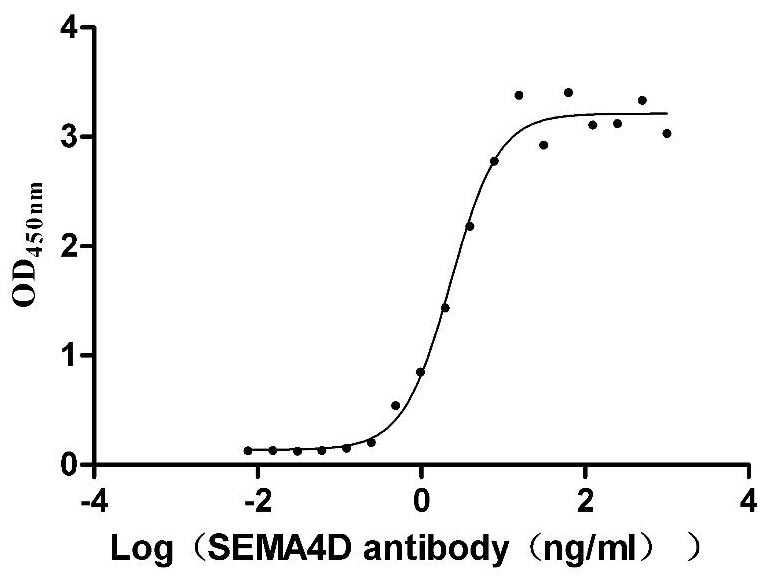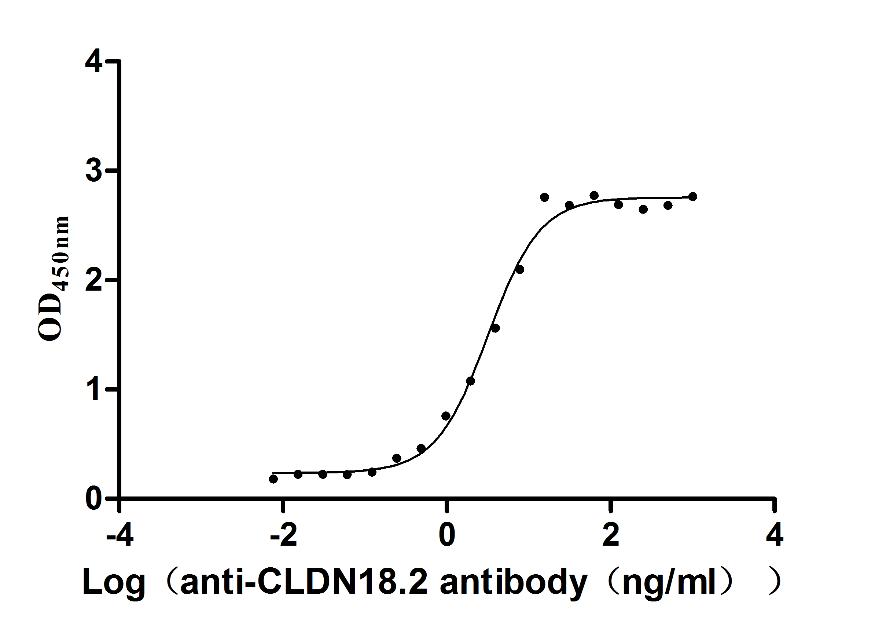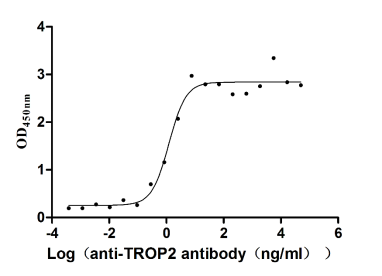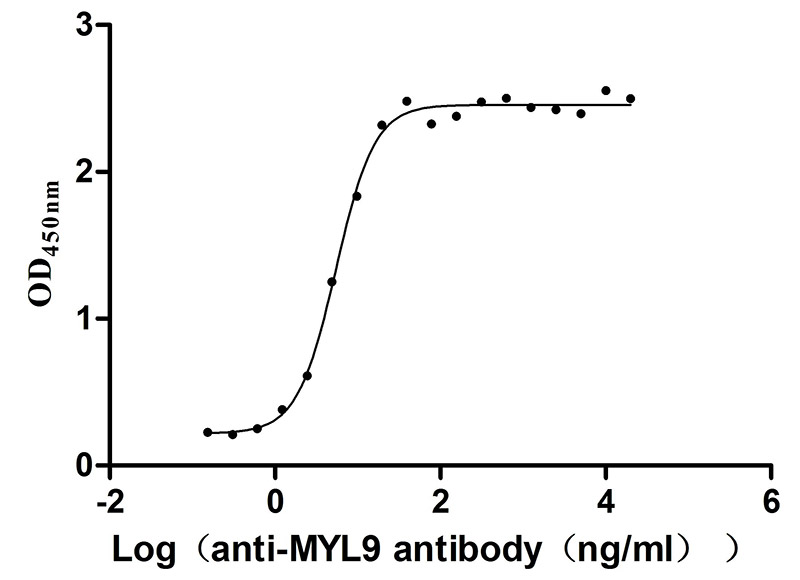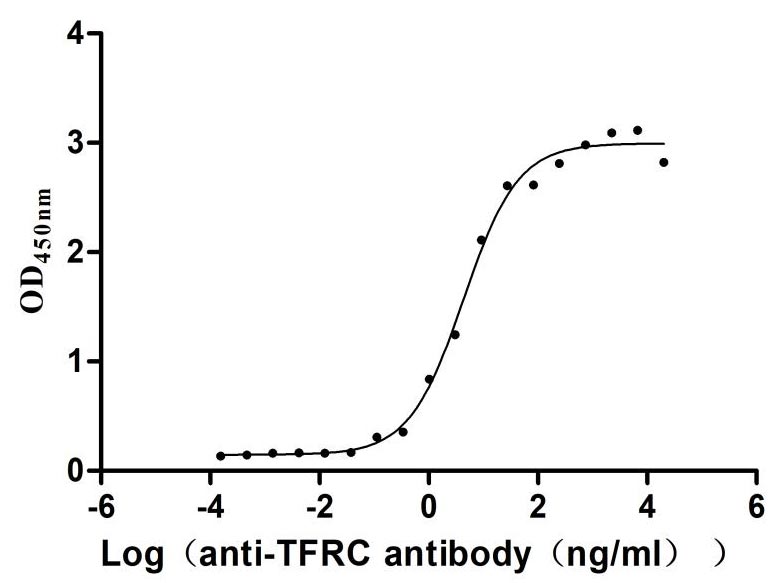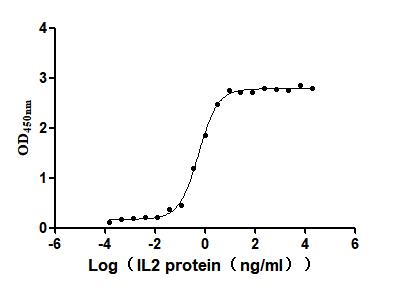Recombinant Human Rho GTPase-activating protein 7 (DLC1), partial
-
中文名称:人DLC1重组蛋白
-
货号:CSB-YP857010HU
-
规格:
-
来源:Yeast
-
其他:
-
中文名称:人DLC1重组蛋白
-
货号:CSB-EP857010HU
-
规格:
-
来源:E.coli
-
其他:
-
中文名称:人DLC1重组蛋白
-
货号:CSB-EP857010HU-B
-
规格:
-
来源:E.coli
-
共轭:Avi-tag Biotinylated
E. coli biotin ligase (BirA) is highly specific in covalently attaching biotin to the 15 amino acid AviTag peptide. This recombinant protein was biotinylated in vivo by AviTag-BirA technology, which method is BriA catalyzes amide linkage between the biotin and the specific lysine of the AviTag.
-
其他:
-
中文名称:人DLC1重组蛋白
-
货号:CSB-BP857010HU
-
规格:
-
来源:Baculovirus
-
其他:
-
中文名称:人DLC1重组蛋白
-
货号:CSB-MP857010HU
-
规格:
-
来源:Mammalian cell
-
其他:
产品详情
-
纯度:>85% (SDS-PAGE)
-
基因名:DLC1
-
Uniprot No.:
-
别名:ARHGAP 7; ARHGAP7; Deleted in liver cancer 1; Deleted in liver cancer 1 protein; DLC 1; Dlc-1; DLC1; DLC1 Rho GTPase activating protein; FLJ21120; HP; HP protein; KIAA1723; p122 RhoGAP; RHG07_HUMAN; Rho GTPase activating protein 7; Rho GTPase-activating protein 7; Rho type GTPase activating protein 7; Rho-type GTPase-activating protein 7; StAR related lipid transfer (START) domain containing 12; StAR related lipid transfer protein 12; StAR-related lipid transfer protein 12; STARD 12; StARD12; START domain containing protein 12; START domain-containing protein 12
-
种属:Homo sapiens (Human)
-
蛋白长度:Partial
-
蛋白标签:Tag type will be determined during the manufacturing process.
The tag type will be determined during production process. If you have specified tag type, please tell us and we will develop the specified tag preferentially. -
产品提供形式:Lyophilized powder
Note: We will preferentially ship the format that we have in stock, however, if you have any special requirement for the format, please remark your requirement when placing the order, we will prepare according to your demand. -
复溶:We recommend that this vial be briefly centrifuged prior to opening to bring the contents to the bottom. Please reconstitute protein in deionized sterile water to a concentration of 0.1-1.0 mg/mL.We recommend to add 5-50% of glycerol (final concentration) and aliquot for long-term storage at -20℃/-80℃. Our default final concentration of glycerol is 50%. Customers could use it as reference.
-
储存条件:Store at -20°C/-80°C upon receipt, aliquoting is necessary for mutiple use. Avoid repeated freeze-thaw cycles.
-
保质期:The shelf life is related to many factors, storage state, buffer ingredients, storage temperature and the stability of the protein itself.
Generally, the shelf life of liquid form is 6 months at -20°C/-80°C. The shelf life of lyophilized form is 12 months at -20°C/-80°C. -
货期:Delivery time may differ from different purchasing way or location, please kindly consult your local distributors for specific delivery time.Note: All of our proteins are default shipped with normal blue ice packs, if you request to ship with dry ice, please communicate with us in advance and extra fees will be charged.
-
注意事项:Repeated freezing and thawing is not recommended. Store working aliquots at 4°C for up to one week.
-
Datasheet :Please contact us to get it.
相关产品
靶点详情
-
功能:Functions as a GTPase-activating protein for the small GTPases RHOA, RHOB, RHOC and CDC42, terminating their downstream signaling. This induces morphological changes and detachment through cytoskeletal reorganization, playing a critical role in biological processes such as cell migration and proliferation. Also functions in vivo as an activator of the phospholipase PLCD1. Active DLC1 increases cell migration velocity but reduces directionality.
-
基因功能参考文献:
- DLC1 is the predominant family member expressed in several normal tissues, and its expression is preferentially reduced in common cancers at these sites. PMID: 27174913
- Fluctuation of reactive oxygen species inhibited migration through reducing the interaction between DLC1 and CAV-1. PMID: 28130753
- IGF2 may exert its oncofunction, at least partly, through its parasitic miR-483 which suppressed DLC-1 in colorectal cancer cells. DLC-1 expression was decreased in colorectal cancer tissues and diminished through transient transfection with miR-483-3p. PMID: 27366946
- The results of this study showed for the first time that CpGs of the DLC1-v1 alternative promoter is frequently hypermethylated in tumors of meningeal origin. PMID: 27614886
- Receptor tyrosine kinase activation of RhoA is mediated by AKT phosphorylation of DLC1. PMID: 29114068
- Study suggests a mechanism for EZH2-H3K27me3 epigenetic repression of DLC1 and multilayered regulation of DLC1/Rho/ROCK signaling by EZH2, and advocated the significant pro-metastatic role of EZH2 via repressing tumor and metastasis suppressors. PMID: 23826380
- The results identify DLC1 as an activator of white and brown adipocyte differentiation, and provide a molecular link between PPARgamma and Rho pathways. PMID: 28358928
- DLC-1 has a positive regulatory role in endothelial cell angiogenesis. PMID: 28408355
- Subsequent studies have demonstrated that DLC-1 is generally expressed in normal human tissues as well as in rats, while it always exists inactivated or even lost in many human cancers, which characterizes DLC-1 as a potential tumor suppressor. [review] PMID: 27604574
- Tumor suppressor genes deleted in liver cancer 1 (DLC1), F-box/WD-repeat-containing protein 7 (FBXW7), and cadherin-6 (CDH6) were identified as presumed targets in Cholangiocarcinoma (CC).Inverse correlation between promoter methylation and expression suggested miR-129-2 and members of the miR-200 family (miR-200a, miR-200b, and miR-429) as novel tumor suppressors and oncomiRs, respectively, in CC PMID: 27593557
- it was demonstrated that the rs621554 polymorphism was correlated with DLC1 expression at the mRNA level. These results suggested that the rs621554 polymorphism is associated with breast cancer susceptibility and prognosis, and may serve as a biomarker for breast cancer development and progression. PMID: 26986853
- curcumin down-regulates the expression of Sp1 to inhibit the expression of DNA methyltransferase 1, thus subsequently reducing hypermethylation of DLC1 promoter to induce DLC1 expression. PMID: 27830358
- DLC-1 acts as a tumor suppressor gene in HCC by regulating the expression of RhoA/ROCK2/ moesin. PMID: 26846339
- Low DLC-1 expression is associated with cancer. PMID: 26514520
- Low expression of DLC1 is predictive of poor therapeutic efficiency of fluoropyrimidine and oxaliplatin as adjuvant chemotherapy in gastric cancer. PMID: 26239822
- No significant association of DLC1 SNPs with the patients' prognosis was found. PMID: 26095787
- A phosphorylation-mediated molecular switch comprising DLC), TNS3, PTEN and PI3K controls the spatiotemporal activation of Rac1 and RhoA, thereby initiating directional cell migration induced by growth factors. PMID: 26166433
- Data suggest BCL2-like 1 protein (BCL2L1) and deleted in liver cancer 1 protein (DLC1) as potential druggable targets for specific subsets of gastric cancer (GC) cases. PMID: 26401016
- Low DLC1 expression is associated with cancer. PMID: 25743845
- During early cell spreading, DLC1 is preferentially localized at the inner/mature adhesions whereas phosphorylated paxillin occupies the outer/nascent focal adhesions. In addition, DLC1 downregulates paxillin turnover PMID: 25448629
- Cooperation of DLC1 and CDK6 affects breast cancer clinical outcome PMID: 25425654
- Studies indicate that deleted in liver cancer-1 (DLC1) contributes to growth and migratory suppressive effects through GAP-dependent and GAP-independent mechanisms. PMID: 24338004
- DLC-1 protein expression was negatively associated with both overall survival and with distant metastasis-free survival, but not with disease-free survival. PMID: 23510351
- The CDK5 kinase phosphorylates four serines in DLC1 located N-terminal to the Rho-GAP domain. PMID: 25452387
- Cox regression analysis determined that strong cytoplasmic and nuclear DLC1 expression was a favorable independent prognostic factor for all melanoma (HR, 0.61; 95% CI) and metastatic melanoma patients (HR, 0.42; 95% CI). PMID: 24557030
- Evidence supports an anti-metastatic role for DLC1 in several human cancers.[Review] PMID: 24519699
- DLC-1 inhibits cell growth and invasion in human colon cancer, functioning as a tumor-suppressor gene, possibly through the regulation of the Wnt/beta-catenin signaling pathway. PMID: 24604602
- DLC-1 is negatively associated with nasopharyngeal carcinoma carcinogenesis, and promoter hypermethylation along with loss of heterozygosity, but not mutation, contributes to inactivation of DLC-1 in nasopharyngeal carcinoma. PMID: 23908159
- It is involved in proliferation and invasion of GBC cells and may serve as a potential therapeutic target. PMID: 24329682
- Our data identify DLC1 as a locus for durable transgene expression that does not incur features of insertional oncogenesis, thus expanding options for developing ex vivo cell therapy mediated by site-specific integration methods. PMID: 24553346
- DLC1 might act as a congenital heart disease-associated gene in addition to its role as a tumor suppressor in cancer. PMID: 24587289
- The expression of DLC1 and PAI-1 were closely related with the metastasis and invasion of ovarian carcinoma, only the combination of DLC1 and PAI-1 could serve as an independent prognostic factor of ovarian carcinoma. PMID: 23988121
- Study demonstrates that DLC1 expression positively regulates E-cadherin and suppresses highly metastatic PCA cell invasion by modulating Rho pathway. PMID: 23376848
- Hypermethylation of DLC1 gene is associated with colon carcinogenesis. PMID: 23783552
- Evaluation of clinical breast tumor samples revealed that reduced DLC1 expression was linked to elevated PTHLH expression and organ-specific metastasis to bone. PMID: 24590291
- DLC-1 inhibits the proliferation, migration and tumorigenicity of human nasopharyngeal carcinoma cells. PMID: 23588806
- DLC1 was ubiquitinated and degraded by cullin 4A-RING ubiquitin ligase (CRL4A) complex interaction with DDB1 and the FBXW5 substrate receptor. PMID: 24082123
- DLC-1 methylation status was an independent prognostic factor for the overall survival rate of pancreatic ductal adenocarcinoma patients. PMID: 23681804
- DLC1 plays a pivotal role in the development and progression of cutaneous squamous cell carcinoma. PMID: 23625658
- analysis of DLC-1 epigenetic silencing in the mucosa-adenoma-carcinoma transformation process of colorectal cancer PMID: 23509688
- study establishes a novel regulatory mechanism for DLC1 RhoGAP activity via dimerization induced by protein kinase A signalling PMID: 23511482
- The abnormal expression of DLC1 and p-FAK might participate in the carcinogenesis, progression, and metastasis of breast cancer. PMID: 21868344
- Downregulation of FAK gene expression or/and upregulation of DLC-1 gene expression can all inhibit the OVCAR-3 cell growth. PMID: 23079702
- Several genes and biochemical activities collaborate with the inactivation of DLC1 to give rise to cell transformation in MEFs, and the identified genes are relevant to human tumors with low DLC1 expression. PMID: 23010077
- The results showed that in breast cancer, DLC-1 gene expression was significantly lower than that in normal breast tissue and benign breast lesions. PMID: 22799310
- Silencing FAK mRNA expression and DLC1 mRNA expression may markedly enhance caspase-3 and caspase-9 activities in ovarian cancer cells. PMID: 22760257
- Aberrant DLC1 methylation and PIK3CA mutations may have important roles in extramammary Paget's disease pathogenesis. PMID: 22522847
- a new mechanism through which DLC1 exerts its strong oncosuppressive function by positively influencing adherens junctions stability PMID: 22473989
- complex formation between the DLC1 START domain and CAV-1 contributes to DLC1 tumor suppression via a RhoGAP-independent mechanism, and suggest that DLC1 inactivation probably contributes to cancer progression. PMID: 22693251
- study provides evidence that MKL1/2 mediates cancerous transformation in DLC1-deficient hepatocellular and mammary carcinoma cells PMID: 22139079
显示更多
收起更多
-
亚细胞定位:Cytoplasm. Cell junction, focal adhesion. Membrane; Peripheral membrane protein. Note=Colocalizes with EF1A1 at actin-rich regions in the cell periphery.
-
组织特异性:Highest level of expression in the spleen, with rather lower levels in prostate, testis, ovary, small intestine and colon, but none in the thymus.
-
数据库链接:
Most popular with customers
-
Recombinant Human Tumor necrosis factor ligand superfamily member 8 (TNFSF8), partial (Active)
Express system: Mammalian cell
Species: Homo sapiens (Human)
-
Recombinant Human R-spondin-1 (RSPO1), partial (Active)
Express system: Mammalian cell
Species: Homo sapiens (Human)
-
Recombinant Macaca mulatta Semaphorin-4D isoform 1 (SEMA4D), partial (Active)
Express system: Mammalian cell
Species: Macaca mulatta (Rhesus macaque)
-
Recombinant Macaca fascicularis Claudin 18.2 (CLDN18.2)-VLPs (Active)
Express system: Mammalian cell
Species: Macaca fascicularis (Crab-eating macaque) (Cynomolgus monkey)
-
Recombinant Human Tumor-associated calcium signal transducer 2 (TACSTD2), partial (Active)
Express system: Mammalian cell
Species: Homo sapiens (Human)
-
Recombinant Human Myosin regulatory light polypeptide 9 (MYL9) (Active)
Express system: Yeast
Species: Homo sapiens (Human)
-
Recombinant Human Transferrin receptor protein 1 (TFRC), partial (Active)
Express system: Mammalian cell
Species: Homo sapiens (Human)
-
Recombinant Human Interleukin-2 (IL2) (Active)
Express system: Mammalian cell
Species: Homo sapiens (Human)


